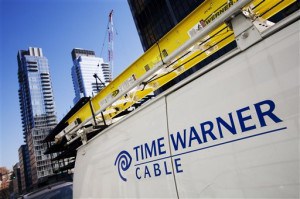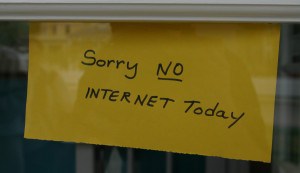 Some communities are luckier than others. When your cable company boosts rates, some consumers have another provider available, letting them take their business elsewhere. That’s especially true if there is another provider in town that doesn’t require you to attach a satellite dish to your roof.
Some communities are luckier than others. When your cable company boosts rates, some consumers have another provider available, letting them take their business elsewhere. That’s especially true if there is another provider in town that doesn’t require you to attach a satellite dish to your roof.
For those who have no other alternative, it’s time for the family meeting to discuss what action, if any, will be taken to deal with a bill that relentlessly increases year after year. The solutions usually come down to “grin and bear it” when paying the higher price, start dropping channels, or go cold turkey and get rid of cable altogether.
In economically troubled western New York, just accepting a higher bill isn’t always an option. For residents of Buffalo, many have the choice of switching from Time Warner Cable to Verizon FiOS. Many Queen City residents have threatened to do just that, often extracting concessions from Time Warner Cable when they call to cancel.
Stop the Cap! reader Marion, who lives in Amherst, wrote she was outraged to receive word of yet another rate hike from Time Warner Cable.
“Our family had been pestered by Verizon ever since FiOS came around our area, but having the phone company tear up your house to rewire everything and change your e-mail address was a real hassle, so we just kept Time Warner,” she writes. “I’m fed up paying for all these filthy channels I never watch and I frankly can’t afford to keep paying them more and more every year whenever they have one of their programmer disputes.”
Marion called to cancel service and was transferred to a “retention specialist” who is trained to rescue departing customers before they cut the cord or show up at the cable office with their set top boxes in hand, waiting to turn them in.
“They always want to argue what a great value they are and how messy and time-consuming FiOS is to install, and you have to pay extra for HD channels I’m too old to appreciate anyway, but I just kept saying ‘cancel’ and said the only thing I cared about was the price,” Marion adds. “In the end they offered to cut the bill twenty dollars a month and give me a discount only new customers would get if I agreed to stay with a term plan. I decided I would, for now. I’m on a fixed income and with no Social Security increase this year, the price is very important to me.”

Alan Pergament is the TV Critic for the Buffalo News
Time Warner Cable is well aware when customers leave. The company’s “churn” rate, measuring departing customers, has been on the increase in highly competitive service areas. Consumers have learned to use new customer promotional offers from the competition against their current provider, threatening to cancel if they refuse to match them. The costs of getting those customers back can be higher than just handing over a temporary discount, so many providers relent and give customers the lower price they want.
In Buffalo, convincing customers the local cable company is a better value and offers better service than the fiber-based FiOS competition might keep customers from thinking about switching in the first place. That’s the idea, anyway.
The Buffalo News Tuesday published an interview with Time Warner’s Jeff Unaitis on the recently-announced rate hike and what changes the company is making to try and hold onto their customers.
Unaitis started with a range of new and upcoming improvements the cable operator is planning to make across upstate New York:
• The 24-hour news channel YNN —or Your News Now—will be the title of all TWC news channels across the state shortly to give it a “seamless news presence across the state.”
“You are beginning to see more shared coverage across the state,” said Unaitis.
Additionally, viewers in Western New York will get an upconverted HD version of YNN on Channel 709 by April or so. In other words, it isn’t shot in HD but it is HD quality. It already has been done on TWC’s news channel in Syracuse. “The reality is when you are accustomed to see HD content going back to something that is standard digital, let alone analog, is more difficult viewing,” Unaitis said.
• A new interactive, user-friendly, online programming guide will be available soon. One bonus: It will be easier to order On Demand titles.
In the next few months, the satellite feature celebrated in the ads with “Pysch” star Dule Hill that allows subscribers to program their DVRs remotely while they are away from home will soon be available to TWC subscribers with this guide.
• TWC is looking at the possibility of expanding “significantly more” HD channels that the public has requested. BBCAmerica, Lifetime and all the Viacom channels (VH1, MTV, Comedy Central and Nickelodeon among them) are among the most requested. “Some of them are contingent on carriage deals,” said Unaitis. “Others we do have the rights to carry, we just haven’t done the engineering required to have them yet.”
• The popular Start Over feature — which is up to 90 channels here and allows viewers to start shows from the beginning during the time window it airs — will be augmented some time this year by a new “Look Back” feature. “Look Back” enables viewers to watch shows for up to 72 hours after they air rather than just the window in which they air.
Unaitis added that viewers may not realize that the Free on HD Demand channel offers subscribers many of the same programs that are available on Prime Time On Demand, but in HD.

YNN provides 24/7 local news coverage on individual channels in Buffalo, Rochester, Syracuse, and Albany
The newspaper’s TV critic, Alan Pergament, noted the service changes, but immediately pelted Unaitis with the concerns local residents actually have about their Time Warner Cable service. To save time, and because of complaints I’ve had about my verbosity, I’ve boiled it all down for you:
Q. Why isn’t Time Warner Sports-Net, the local sports channel, in HD?
A. Because it costs too much, but Unaitis claimed the channel will be upconverted to HD, which will “give it an HD-quality signal.” Not really.
Q. Buffalo gets Canadian networks from Toronto-area stations on their lineup. Why aren’t they available in HD?
A. Who knows.
Q. Why can’t people pay for only the channels they want?
A. Because programmers won’t allow it, and the cable company would end up charging you the same price you pay for 75 channels today that you’ll pay for 20 channels tomorrow. Plus, you’ll need a box on every TV in the house and that also increases your bill.
Q. How much do western New Yorker’s pay for YNN?
A. None of your business.
Q. How many subscribers does Time Warner Cable have in western New York?
A. None of your business.
Q. Why do those in western NY pay a higher price for cable service than elsewhere?
A. Unaitis didn’t know if that was true or not, but then explained it was because of the weather, labor costs, high state taxes and the difficulty building and maintaining the cable lines.
Okay, then.


 Subscribe
Subscribe








